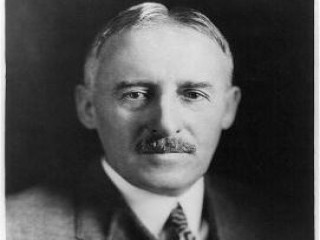
Henry Lewis Stimson biography
Date of birth : 1867-09-21
Date of death : 1950-10-20
Birthplace : New York City, New York, US
Nationality : American
Category : Politics
Last modified : 2011-06-09
Credited as : Statesman, and lawyer, mission to Nicaragua
Henry Stimson was born on Sept. 21, 1867, in New York City of a family of substantial means. He was educated at Phillips Exeter Academy, Yale University (class of 1888), and Harvard Law School (class of 1891). He then joined one of the most prestigious law firms in New York.
Stimson became a highly successful lawyer and a rich man, but he was deeply interested in public affairs. From 1906 to 1909, as U.S. district attorney in New York, he distinguished himself by his energy in carrying out the trust-busting policies of President Theodore Roosevelt. In 1910 Roosevelt persuaded him to run for the governorship of New York. Never very impressive as a public speaker, and handicapped by the nationwide reaction against the Republican party, to which he belonged, Stimson lost. From 1911 to 1913 he was secretary of war in the administration of President William Howard Taft. Never one to avoid responsibility, he worked to improve the armed services under his control. In private life from 1913 to 1917, he enlisted in the Army with the coming of World War I, serving briefly in France.
In 1927 President Calvin Coolidge appointed Stimson to a mission to Nicaragua. He helped bring the civil war there to a conclusion and laid the foundations for what came to be known as the good-neighbor policy toward Latin America. From December 1927 to March 1929 he served a brilliantly successful term as governor general of the Philippines.
Stimson was secretary of state in the administration of President Hoover from 1929 to 1933. Stimson faced a multitude of vexing problems, made more difficult by strained relations with the President, who in many ways wanted to be his own secretary. Most important was the situation in the Far East. In 1931 the Japanese army began conquering the Chinese province of Manchuria (hitherto under a limited Japanese occupation) and set up a puppet regime. The League of Nations attempted to arrest the aggression without result. Stimson, unable to cooperate with the League, addressed identical notes to Japan and China declaring that the United States did not intend to "admit the legality of any situation or recognize any treaty or agreement which violated the rights of the United States or of the Republic of China." This later became known as the Stimson Doctrine, but it was ineffectual in ending the dispute.
In 1933 Stimson resumed his law practice. When the Democrats came to power, President Franklin Roosevelt appointed him secretary of war in 1940. Though Stimson was a Republican, he accepted and brilliantly administered the War Department. He chose remarkable lieutenants and must be credited with a great accomplishment. He had a part in developing and launching the atomic bomb. His critics have alleged that he took insufficient measures to warn the American Army leaders at Pearl Harbor before the Japanese attack. He resigned as secretary in 1945 and died in Huntington, Long Island, on Oct. 20, 1950. Few men have ever served the U.S. government more usefully or with greater devotion.
















